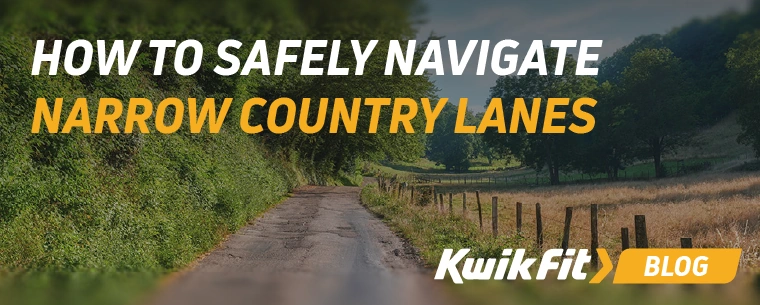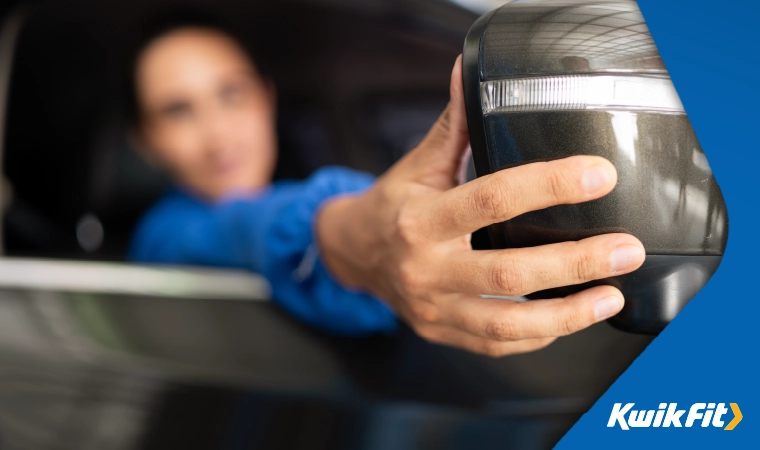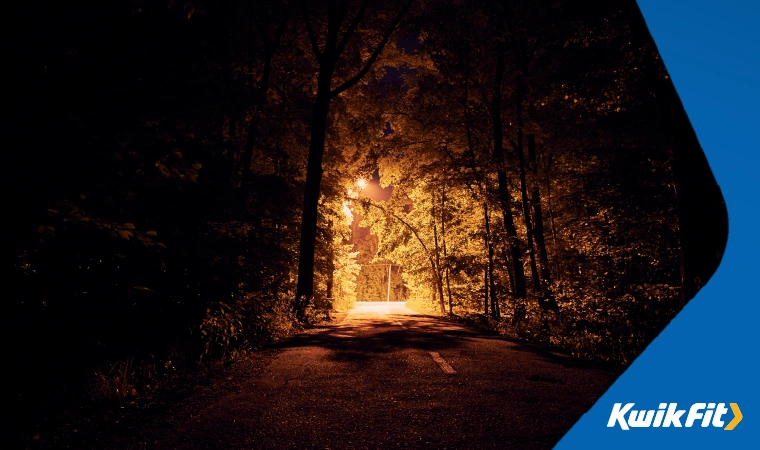How to Safely Navigate Narrow Country Lanes
Jack Dreyer | Monday 7th October 2024 12:00pm

According to government statistics, 35% of motor vehicle miles travelled in Great Britain in the year ending 2024 were on minor roads. That’s a lot of vehicles competing for space on some of the UK’s narrowest roads!
Unless you were born and bred in the country, we’d forgive you for not feeling completely at home on narrow rural roads — especially in the dark or during periods of bad weather. Often plagued by blind corners, sudden inclines, minimal width, and few opportunities for passing safely, country roads have become the bane of many drivers’ existence. And, when you consider that 79% of the UK’s 245,000 miles of roads are classed as C or U categories, that’s a lot of country lanes. But we’re here to change any misgivings you might have.
In this blog, we’ll take you through the perils of country lanes and arm you with motoring tips to navigate them safely. So, by the time you’re done reading, you’ll feel as though you could drive a combine harvester around a hamlet — blindfolded.
The challenges posed by country lanes

Before we talk you through exactly how to navigate rural lanes, let’s take a closer look at what makes them so challenging for drivers — new and experienced — up and down the country.
Lack of visibility
Country lanes are notoriously riddled with sharp corners and blind bends that can make driving align them feel like waiting for a jump scare to happen. In the summer months especially, when hedgerows, trees, and shrubbery are at their thickest, there is far less road to see.
Poorly maintained roads
While we know that Britain on the whole isn’t the best at keeping its roads in good condition, rural roads in particular suffer terribly from the pothole epidemic. Since ‘minor’ roads are often deemed a lower priority (and are usually agricultural in nature), they can feel more like dirt tracks than roads at times which makes things harder.
Unfamiliar hazards
Rural lanes have a much higher likelihood of ‘unusual’ hazards than regular dual carriageways or motorways. Livestock crossing, flooding, speed bumps, bridges, and cattle gates are far more common on these types of roads and frequently catch out new drivers, as well as those who aren’t used to navigating ‘out in the sticks’.
Irregular lighting
One of the main reasons why country lanes are so unpopular — among motorists, cyclists, and pedestrians alike — is because of their irregular lighting at night. Way out in the country, not all minor roads are equipped with streetlights of the same calibre as the ones you’ll find on the M25 and other major roads. This can make them feel dangerous for road users (especially as there are no designated pavements or cycle lanes either) as navigating and spotting hazards in good time is unquestionably much harder in the dark.
However, despite those difficult elements, many drivers say they actually prefer country lanes! Why? A combination of things: there’s less traffic in general, there’s less need for complicated manoeuvres, and the views are nicer.
Tips for driving safely on narrow country lanes
Regardless of whether driving along country lanes strikes fear into your heart or sounds like a lovely afternoon out, safety on this type of road is paramount. So, below we’ll walk you through some practical guidance to feel more at home out on those country lanes.
Starting off with some top-level tricks:
- Slow down: Ease off that accelerator; if you’re stationary, you physically cannot hit anyone. And, if you’re going slowly, you have more time for decision-making around those sharp bends.
- Use that horn: It’s completely fine to use the horn to alert drivers of your presence in certain situations where they would be unaware of your presence otherwise (such as going around a sharp corner overgrown with grass).
- Keep over: Country lanes are narrower so don’t be a road hog and straddle the middle — keep to the left at all times.
- Don’t stray far from the brake pedal: Be prepared to stop suddenly — for livestock, for an oncoming vehicle, or even for debris in the road.
- Use your ears: Everything’s quieter in the countryside and oftentimes you can actually hear cars approaching before you can see them. If it’s a nice day, wind your window down and lean on your senses a little more.
Now we’ll take a closer look at some of the hazards in more detail, offering helpful solutions.
Meeting oncoming traffic on narrow country lanes
‘This lane ain’t big enough for the both of us…’ you think as a 4x4 comes hurtling round the corner towards you. We’ve all been there, grimacing as there’s just centimetres between our wing mirror and theirs. Here’s what to do when you find yourself in this kind of scenario:
- Give way: If you see the approaching vehicle early enough, stay put and tuck your car in over to the left so that they have room to pass.
- Use a passing place: Oftentimes, country roads usually have wider sections that can act as ‘passing places’ for two vehicles to get around each other safely. Try to be aware where your nearest passing place is (this may require you to reverse some).
- Communicate: If it’s daylight, usually you can gesture to other drivers that you are getting over or require them to reverse a little.
Tip: Many drivers panic when meeting oncoming traffic and immediately turn sharply to the left (often into a hedge or a wall), sacrificing their paintwork as they do so. Try not to take any drastic action and assess your surroundings before moving your vehicle to accommodate others.
Driving on country lanes with poor visibility

We understand that driving on narrow, rural roads is nerve-wracking at the best of times, let alone when you’re tired and visibility is poor at night. So, we’ve devoted this section to giving you helpful tips for navigating those pesky narrow lanes after dark and when the weather isn’t your friend.
At night
When driving on narrow lanes in (what feels like) the middle of nowhere at night, rely on those headlights to give you better visibility of the road ahead — just be careful not to dazzle other drivers. Full-beam headlights should not be used when approaching the brow of a hill or going around blind bends as you may accidentally dazzle oncoming traffic.
Other drivers’ headlights may seem dazzling to you, so learn how to utilise the anti-dazzle feature on your rear-view mirror. Aside from this, the headlights of other drivers can also be a tool for you. Try to look further ahead than usual when navigating country roads at night and you may be able to spot headlights in the distance, especially reflecting against hedges around blind bends.
You can find plenty more advice on night time driving in another of our blogs.
During bad weather
If there’s been a frost and the roads are slippery or have black ice, you’ll need to adjust your driving techniques regardless of what road type you’re on. If it’s icy out, you should do the following when driving on country lanes:
- Brake gently to avoid sudden stops, skidding, and rear-end collisions
- Slow right down when going around corners to reduce the risk of spinning out
- Consider whether making the journey is 100% necessary if the weather is bad enough
- Use fog lights in times of extreme reduced visibility
- Ensure your windscreen wipers are in good condition to handle lots of rain
Country roads, take me home!
And there you have it. See, driving along country roads is not so scary after all. What does help to significantly reduce the fear factor, though, is having a car that you know won’t let you down.
Getting your car regularly serviced at your local Kwik Fit, as well as booking it for a free Vehicle Safety Check and Brake Check is a sure fire way to give you the peace of mind you need to feel safer behind the wheel — whether you’re driving through fields late at night or not.
Dealing with anxiety about driving at large? Brush up on the driving foundations and learn some tips to boost your confidence over on the Kwik Fit blog.
Any facts, figures and prices shown in our blog articles are correct at time of publication.
Featured Articles
Is it Illegal to Drive With One Headlight?
Saturday 19th July 2025
Wondering if it’s illegal to drive with one headlight? Learn about the safety risks and penalties of illegal blown bulbs and why you should fix them promptly.
Air Con in EVs & Hybrids: Experts Answer Your Questions
Monday 30th June 2025
Does air con drain EV batteries? Can you use the air con while charging an electric car? Find out the answers to these questions & more from Kwik Fit’s experts.
Why Is Your Car Making a Noise? Fixes & Tips
Friday 13th June 2025
When your car starts making unexpected noises, it can certainly be quite disconcerting; it may be nothing to worry about, but here’s what you need to know.









